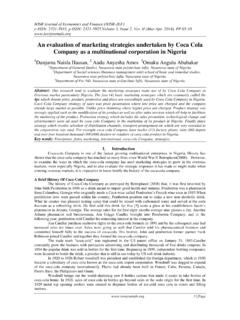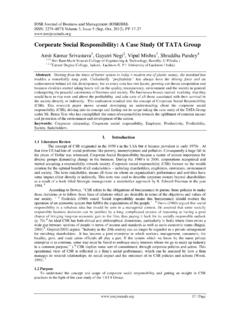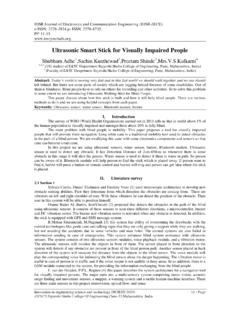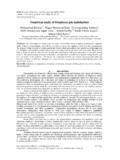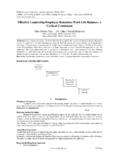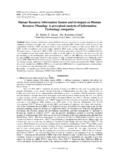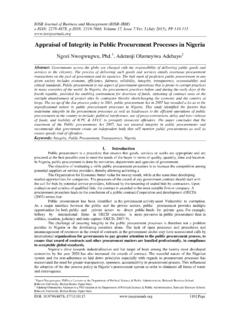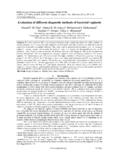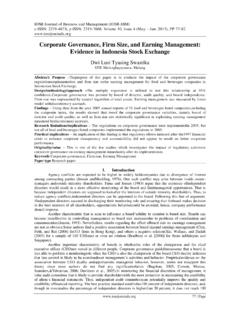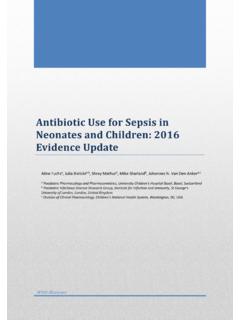Transcription of Antibiotic susceptibility pattern of Klebsiella …
1 IOSR Journal of Pharmacy and Biological Sciences (IOSRJPBS). ISSN : 2278-3008 Volume 1, Issue 2 (May-June 2012), PP 04-09. Antibiotic susceptibility pattern of Klebsiella pneumoniae isolated from sputum, urine and pus samples 1. , , 3Dr. rao, Panda 1. , Assistant Professor, , 2 Professor and Head., , Professor., , Professor. Department of Microbiology, Maharajah's institute of medical sciences, Nellimarla,Vizianagaram, Andhrapradesh, India. Abstract Introduction: Gram-negative pathogens are an important cause of hospital acquired infections throughout the world. Klebsiella pneumoniae has become one of the more common causes of nosocomial infections. Materials and methods: A total number of 1264 urine, 544 pus and 784 sputum samples from January 2008 to October 2010 were included in the study. Isolates of Klebsiella pneumoniae were identified by their morphological and biochemical characteristics. All the isolates of Klebsiella pneumoniae identified were subjected to Antibiotic sensitivity testing by modified Kirby-bauer disc diffusion method.
2 Results: The number of Klebsiella pneumoniae isolates were 254 from 1264 urine samples, 135 from 544 pus samples and 191 from 784 sputum samples. Majority of the strains isolated were sensitive to Amikacin. Conclusion: The present study from 2008 to 2010 reveals the incidence of infections due to Klebsiella pneumoniae strains in the hospitalized patients and their tendency towards Antibiotic resistance. Key words: Kebsiella pneumoniae , nosocomial infections, pneumonia, urinary tract infections, beta-lactamase, ESBL's, Gram-negative, non-motile, urease. Introduction Klebsiella pneumoniae is a Gram-negative, non-motile, encapsulated, lactose fermenting, facultative anaerobic, rod shaped bacterium found in the normal flora of the mouth, skin and the recent years, Klebsiella pneumoniae has become important pathogen in nosocomial infections. Klebsiella pneumoniae is most frequently recovered from clinical specimens and can cause a classic form of primary pneumonia.
3 Klebsiella pneumoniae can also cause a variety of extrapulmonary infections, including enteritis and meningitis in infants, urinary tract infections in children and adults and septicaemia. In the United States, Klebsiella accounts for 3-7%. of all nosocomial bacterial infections, placing them among the eight most important infectious pathogens in hospitals. Klebsiellae have a tendency to harbor Antibiotic resistant plasmids; thus, infections with multiple Antibiotic -resistant strains can be anticipated. Virtually all clinical strains are resistant to ampicillin, carbenicillin, and ticarcillin. Of particular concern is the recent appearance of Klebsiella strains that possess plasmids that mediate resistance to ESBL. drugs. This form of resistance is due to the production of unique beta-lactamase enzymes, referred to as ESBL's. These enzymes have been seen mostly in strains of Klebsiella pneumoniae and , and cause them to be resistant to most beta-lactam drugs, including the third generation cephalosporins.
4 Aim of the present study was to know the Antibiotic sensitivity pattern of Klebsiella pneumoniae strains isolated from sputum, urine and pus samples sent to Microbiology laboratory from 2008 to 2010. Materials and methods Sputum, urine, and pus samples collected from inpatients admitted into clinical wards were sent to Microbiology laboratory. The samples were inoculated on blood agar and mac conkey agar and incubated overnight at 37 C. Klebsiella pneumoniae strains were identified by their morphology and biochemical characteristics. Morphology of Klebsiella pneumoniae identified were large, dome-shaped, mucoid colonies on blood agar and lactose fermenting colonies on mac conkey agar. In Gram-staining, gram-negative, short, plump, straight rods were seen. The biochemical characters identified were negative indole test, negative methyl red test, positive voges-proskauer test, positive citrate utilization test, positive urease test, acid and abundant gas production from glucose, lactose, sucrose, maltose and mannitol sugar fermentation tests.
5 Antibiotic sensitivity testing was done for all the isolates on Mueller-hinton agar by modified Kirby-bauer disc diffusion following Antibiotic discs were used for testing bearing the concentrations: Pus and sputum samples: 4 | Page Antibiotic susceptibility pattern of Klebsiella pneumoniae isolated from sputum, urine and pus samples - 10mcg. - 30mcg. +Sulbactum - 10mcg/10mcg - 30mcg. - 30mcg. - 10mcg. - 5mcg. - 30mcg. Urine samples: +Sulbactam 10mcg/10mcg. 30mcg. 25mcg. 30mcg. 30mcg. 10mcg. 300mcg. 5mcg. - 30mcg. Results Table - 1. Total samples: Sample 2008 2009 2010 Total Sputum 267 297 220 784. Pus 180 191 173 544. Urine 386 486 392 1264. Table 2. Culture positivity of Klebsiella pneumoniae : Sample 2008 2009 2010. Sputum N=54( ) N=72( ) N=65( ). Urine N=83( ) N=90( ) N=81( ). Pus N=45(25%) N=54( ) N=36( ). 5 | Page Antibiotic susceptibility pattern of Klebsiella pneumoniae isolated from sputum, urine and pus samples Table - 3: Antibiogram of Klebsiella pneumoniae isolated from pus samples: NAME 2008 (N=45) 2009 (N=54) 2010 (N=36).
6 SENSITIVE RESISTANT SENSITIVE RESISTAN SENSITIVE RESISTANT. T. NO % NO % NO % NO % NO % NO %. AMOXYCLAV 29 64. 16 35. 32 59. 22 40. 20 16 44 56 26 74 5 5. CEFOTAXIME 24 53. 21 46. 29 53. 25 46. 17 19 33 67 71 29 2 8. AMIKACIN 34 75. 11 24. 38 70. 16 29. 24 12 56 44 37 63 7 3. GENTAMICIN 30 66. 15 33. 32 59. 22 40. 21 15 67 33 23 74 3 7. AMPICILLIN+SULB 26 57. 19 42. 30 55. 24 44. 19 17 ACTUM 78 22 55 44 8 2. OFLOXACIN 19 42. 26 57. 28 51. 26 48. 17 19 22 78 85 15 2 8. TETRACYCLINE 20 44. 25 55. 23 42. 31 57. 15 21 45 56 59 41 7 3. NETILMICIN 26 57. 19 42. 31 57. 23 42. 22 14 78 22 41 59 1 9. CEFTRIAXONE 23 51. 22 48. 28 51. 26 48. 15 21 11 89 85 15 7 3. 6 | Page Antibiotic susceptibility pattern of Klebsiella pneumoniae isolated from sputum, urine and pus samples Table - 4: Antibiogram of Klebsiella pneumoniae isolated from sputum samples: NAME 2008 (N=54) 2009(N=72) 2010(N=65). SENSITIVE RESISTANT SENSITIVE RESISTANT SENSITIVE RESISTAN.
7 T. NO % NO % NO % NO % NO % NO %. AMOXYCLAV 33 21 42 30 35 30 46. 15. CEFOTAXIME 28 26 38 34 31 34 52. 31. AMIKACIN 36 18 44 28 37 28 43. 08. GENTAMICIN 28 26 34 38 30 35 53. 85. Ampicillin+Sulbactum 30 24 39 33 34 31 47. 69. OFLOXACIN 27 50 27 50 38 34 30 35 53. 85. TETRACYCLINE 26 28 33 39 26 40 39 60. NETILMYCIN 34 20 43 29 39 60 26 40. CEFTRIAXONE 26 28 33 39 27 38 58. 46. 7 | Page Antibiotic susceptibility pattern of Klebsiella pneumoniae isolated from sputum, urine and pus samples Table - 5: Antibiogram of Klebsiella pneumoniae isolated from urine samples: Name. 2008(N=83) 2009(N=90) 2010(N=81). SENSITIVE RESISTANT SENSITIVE RESISTANT SENSITIVE RESISTANT. NO % NO % NO % NO % NO % NO %. NITROFURATOIN 42 41 43 47 38 43 Co-trimoxazole 41 42 42 48 35 46 OFLOXACIN 46 37 45 50 45 50 38 43 GENTAMICIN 51 32 52 38 42 39 AMIKACIN 65 18 67 23 58 23 CEFAZOLIN 48 35 41 49 35 46 Ampicillin+Sulbactam 54 29 55 35 48 33 CEFTRIAXONE 44 39 43 47 37 44 Discussion Klebsiella pneumonia is most frequently recovered from clinical specimens and can cause a classic form of primary is infrequently found in the oropharynx of normal persons(1-6% carrier rate).
8 However, a prevalence rate as high as 20% may occur in hospitalized higher incidence of infections due to Klebsiella pneumonia during the past decade probably reflects both an increase in nosocomial infections in the debilitated or immunosuppressed individuals and a trend towards greater Antibiotic resistance. In the present study from 2008 to 2010, culture positivity for Klebsiella pneumoniae was for sputum samples, for urine samples and for pus In the present study, majority of the strains islated were sensitive to amikacin( P Value= ).The percentage of sensitivity to amikacin was in 2008, in 2009,and in 2010 for pus samples; in 2008, in 2009 and in 2010 for sputum samples and in 2008, in 2009 and in 2010 for urine samples; Thus showing a gradual increase in resistance and decrease in sensitivity. Conclusion The present study from 2008 to 2010 reveals the incidence of infections due to Klebsiella pneumoniae strains in the hospitalized patients and their tendency towards Antibiotic resistance.
9 Majority of the strains isolated were sensitive to amikacin. A gradual increase in resistance and decrease in sensitivity was observed for all the drugs tested towards Klebsiella pneumoniae strains isolated from sputum, urine and pus samples from 2008 to 2010. 8 | Page Antibiotic susceptibility pattern of Klebsiella pneumoniae isolated from sputum, urine and pus samples Referrences: [1] Mehrgan, Mohammad Rahbar, Zohreh Arab-Halvaii, High prevalence of extended spectrum beta lactamase producing Klebsiella pneumoniae in a tertiary care hospital in Tehran, Iran , The Journal of infection in developing countries, , ,2009. [2] , , , , , , Prevalent phenotypes and Antibiotic resistance in Escherichia coli and Klebsiella pneumonia at an Indian tertiary care hospital: plasmid-mediated cefoxitin resistance , International journal of infectious diseases, , issue 3, May 2008, Pg:256-264. [3] , Sadat , , Bacteriuria by extended spectrum beta lactamase producing Escherichia coli and Klebsiella pneumonia isolates in a government hospital in south of Tehran, Iran, Iranian journal of kidney diseases, 2008.
10 Oct;2(4):197-200. [4] Y Varaiya, Jyotsana D Dogra, Manasi H Kulkarni, Pallavi N Bhalekar, Extended spectrum beta lactamase producing Escherichia coli and Klebsiella pneumonia in diabetic foot infections , Indian journal of medical microbiology, , issue 3, 2008, Pg:370-372. [5] 5. , , Drug sensitivity patterns of bacterial isolates from septic post-operative wounds in a regional referral hospital in Uganda , Journal of African health sciences, 2007 Sep:7(3):Pg:148-54. [6] , , , , Antibiotic susceptibility pattern of urinary isolates in Imphal(Manipur), India , Nepal medical college journal, 2007 Sep;9(3):170-2. [7] KL, Gowrish , Sugandhi rao, Sreeja , Prevalence of extended spectrum beta lactamases in urinary isolates of Escherichia coli, Klebsiella and Citrobacter species and their antimicrobial susceptibility pattern in a tertiary care hospital, Indian journal for the Practising Doctor, , (2007-01-2007-02). [8] loivukene,Epp Sepp, Vivika Adamson, Piret Mitt, Ulle Kallandi, Karin Otter, Paul Naaber, Prevalence and Antibiotic susceptibility of Acinetobacter baumanni, Pseudomonas aeruginosa and Klebsiella pneumonia in Estonian intensive care units in comparison with European Data , Scandinavian journal of infectious diseases, 2006, , ,Pg:1001-1008.
